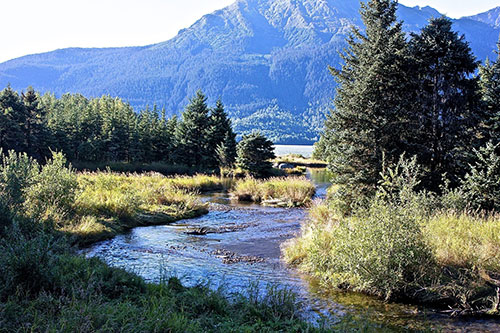
The Tongass Rainforest is Alaska's First Line of Climate Change Defense
January 18, 2016
In November 2015, the U.S. Forest Service issued a Draft Environmental Impact Statement to transition the Tongass out of old-growth logging but the agency plans to continue logging carbon-rich, old-growth rainforests as it slowly transitions logging to younger trees.
A small glimpse of the nearly 17 million acres, of the Tongass National Forest in Southeast Alaska
Report author, Dr. Dominick A. DellaSala, Chief Scientist of Geos Institute, stated, "Cutting down Tongass old-growth rainforest is like smoking cigarettes, it harms the ability of rainforests to filter greenhouse gases contributing to the melting of Alaska's magnificent glaciers." DellaSala used published estimates of carbon stored in Tongass rainforest and carbon dioxide emissions known to occur when rainforests are cut down from decomposition of logging slash and use of fossil fuels in transport and manufacture of wood products. Logging emissions were expressed as equivalent vehicle emissions using an EPA equivalence calculator and compared to an emissions standard proposed by the White House Council on Environmental Quality (CEQ) to keep federal actions in check. Key Findings of the Report:
Last September, President Obama toured Alaska to view the State's melting glaciers and showcase his climate change initiatives prior to the Paris conference in December. The President described Alaska as a "signpost" for the nation's climate change impacts. Regarding the President's Alaska interests, Former Deputy Chief of the U.S. Forest Service Jim Furnish, who oversaw a similar transition on the Siuslaw National Forest in Oregon during the Clinton Administration, noted "the Forest Service needs to do a better job of speeding up the transition by getting out of controversial old-growth timber sales and supporting the timber industry through young growth sales that save jobs and Alaska's climate." At nearly 17 million acres, the Tongass National Forest in southeast Alaska is the crown jewel of the national forest system. It stores more carbon than any national forest, contains world-class salmon runs and wildlife populations, and is one of the world's last relatively intact temperate rainforests. Scientists have recognized the Tongass as a climate refuge for rainforest species. Citing the United Nation's programme to reduce emissions from forest losses, DellaSala added, "The Obama Administration is using a double standard of paying other countries not to destroy tropical rainforests, while logging the Tongass rainforest. We need bold action to save the Tongass and its climate now, not baby steps that drag transition through years of controversial old-growth logging in one of the world's most important temperate rainforests." Geos Institute was one of six conservation groups that requested the Forest Service develop a "conservation alternative" to speed up its transition. The agency prematurely rejected the alternative in its Draft Environmental Impact Statement before studies were completed on young forest inventories designed to aid the transition.
On the Web:
Edited by Mary Kauffman, SitNews
Source of News:
|
||
